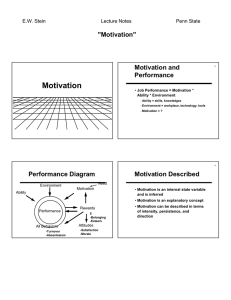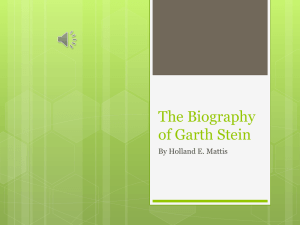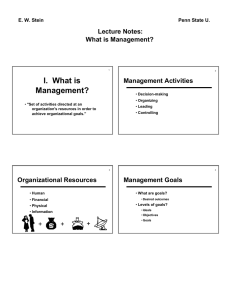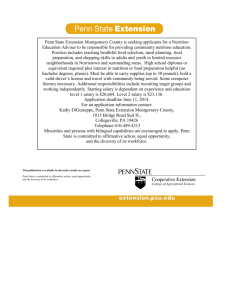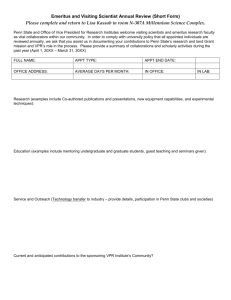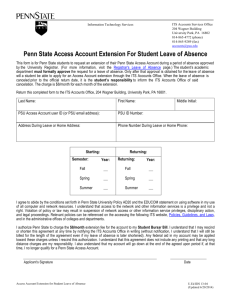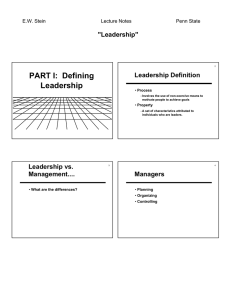Components of Organizational Structure Part I: Job Design
advertisement
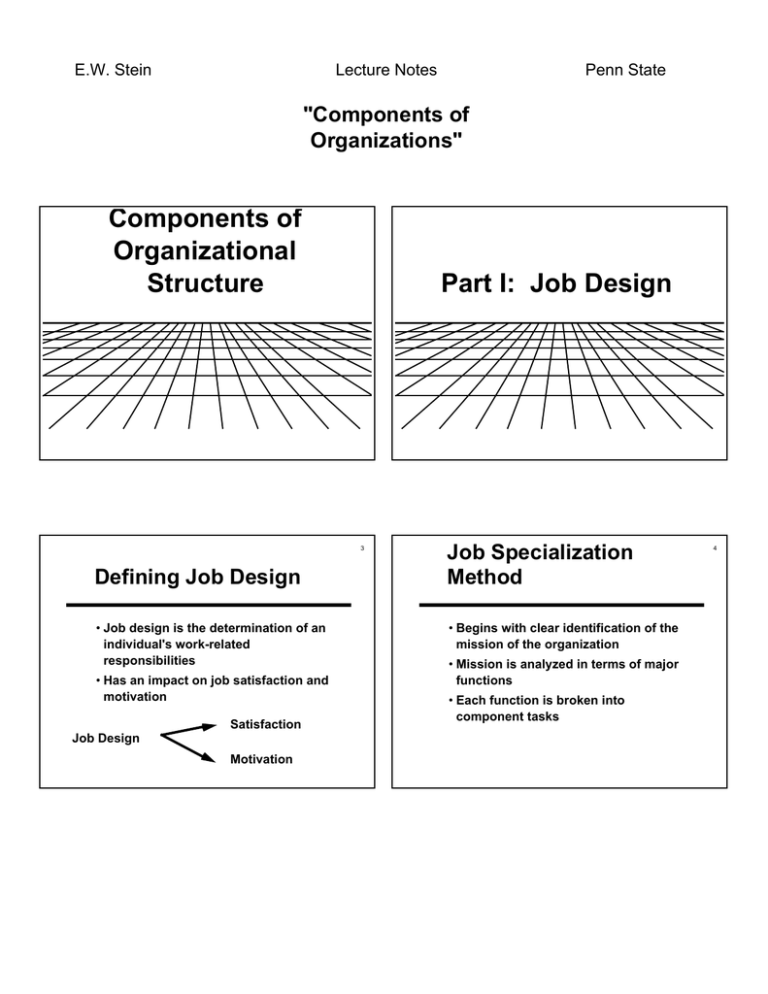
E.W. Stein Lecture Notes Penn State "Components of Organizations" Components of Organizational Structure Part I: Job Design 3 Defining Job Design • Job design is the determination of an individual's work-related responsibilities • Has an impact on job satisfaction and motivation Satisfaction Job Design Motivation Job Specialization Method • Begins with clear identification of the mission of the organization • Mission is analyzed in terms of major functions • Each function is broken into component tasks 4 E.W. Stein Lecture Notes Penn State "Components of Organizations" Benefits of Job Specialization 5 • Workers gain proficiency in simple tasks Costs of Job Specialization • Leads to boredom and dissatisfaction • Dissatisfaction can lead to absenteeism and lower performance • Lower training costs • Simplifies supporting equipment design Job Specialization Dissatisfaction Poor Performance Other Job Design Techniques • Job rotation 6 Absenteeism 7 8 Job Rotation • Job enlargement • Moving employees from one job to another • Job enrichment • Limited use in practice • Used for training E.W. Stein Lecture Notes Penn State "Components of Organizations" 9 10 Job Enlargement Job Enrichment • Increases the total number of tasks that a worker performs • Increase in the variety of tasks performed AND worker control - Increases level of "task variety" • Requires that the more authority be given to workers • Adds to training costs • Unions demand higher salaries • Work is structured in more complete and logical units • Does not change the challenge of each task • Requires a systematic analysis of functions and tasks - Seldom performed Job Characteristics Design Approach • Jobs are analyzed and improved along 5 dimensions: - Skill Variety - number of activities performed - Task Identify - identity of task relative to whole job - Task Significance - perceived importance of task - Autonomy - the degree of control worker has over work performed - Feedback - when the worker knows quality of job performance 11 Job Characteristics Model Factor Psych. State Skill Variety Task identity Task Significance Meaningfulness of work Autonomy Experienced responsibility Feedback Knowledge of results Outcome •High motivation •High performance •High satisfaction •Low turnover 12 E.W. Stein Lecture Notes Penn State "Components of Organizations" Summary of Job Design 13 Part II: Departmentalization • Jobs are the fundamental unit of the organization's task environment • Job design involves many considerations • Job design requires a method 15 16 Departmentalizing Functional Groups • Logical grouping of jobs • Advantages • Common ways to group jobs - By function - By product - By customer - By location - Establishes core knowledge in each function (e.g., finance, engineering, sales) - Easier to manage because less variety of job functions to coordinate - Cognitive and information processing demands are lower for supervisors because jobs are similar E.W. Stein Lecture Notes Penn State "Components of Organizations" Functional Groups (cont) 17 18 Product Groups • Disadvantages • Advantages - Slows and delays decision-making - Promotes integration and coordination of product lines - Accountability for product line is diffused; harder to measure - Improves speed of decision making - Sub-optimization principle - lose sight of organizational goals - Improves ability to assess and account for individual product performance - Interdepartmental rivalries and politics 19 20 Product Groups (cont.) Customer Groups • Disadvantages • Advantages - Encourages narrow product focus at expense of whole organization; "sub-optimization" - Functional redundancy and higher cost - Competition for resources among product groups - Structures organization to build core competence around needs of its customers - Promotes better customer service and responsiveness • Disadvantages - Problems with coordination and integration - Higher administrative costs E.W. Stein Lecture Notes Penn State "Components of Organizations" 21 Geographic Groups Part III: Reporting Structures • Advantages - Structures organization to build core competence around needs of its market niches based on region - Promotes responsiveness to regional needs and changes • Disadvantages - Problems with coordination and integration - Higher administrative costs Reporting Structure Concepts • Chain of Command - Unity of command - each person has a clear reporting relationship to one and only one boss - Scalar Principle - clear and unbroken line from the lowest to the highest position in the organization • Span of Control - The number of people who report to a manager 23 24 Span of Control • Cognitive demands on manager rise with number of interactions • All Interactions = Direct + Cross + Groups • I = N (2 [EN] /2 + N - 1) • Example: N = 4 >>> 44 • Example: N = 10 >>> 5,210 • Example: N = 100 >>> 6.3 X 10 [E31] !!!! E.W. Stein Lecture Notes Penn State "Components of Organizations" Span of Control (cont1) 25 • Low N gives rise to tall organizations • Information technologies make possible flatter structures • Advantages of flat organizations - Fewer layers - Promotes communication - Less expensive - Employees like fewer layers • Disadvantages - Can lead to managerial overload and burnout 26 • High N gives rise to flat organizations 27 Flat Organizations Span of Control (cont2) 8-Factor Model for Span of Control • 1. Competence of supervisor and subordinates • 2. Physical dispersion of subordinates • 3. Extent of nonsupervisory work in manager job • 4. Degree of required interaction 28 E.W. Stein Lecture Notes Penn State "Components of Organizations" 29 Model (cont.) Part IV: Distributing Authority • 5. Extent of standardized procedures • 6. Similarity of tasks being supervised • 7. Frequency of new problems • 8. Preferences of supervisors and subordinates 31 32 Defining Authority Delegating Authority • The concept of authority allows certain members of the organization to make decisions pertaining to human and technological resources • Delegation is the transfer and assignment of authority from one person to another • Three step process: • Authority can be distributed - Assign responsibility • The distribution of authority determines different organizational forms - Grant authority - Create responsibility E.W. Stein Lecture Notes Penn State "Components of Organizations" Impact of Authority on Organizational Forms • Centralized organizations - Authority is concentrated at the top of the organization - Appropriate when decisions involve high risk - If organization lacks confidence in lower level DM's 33 34 Impact (cont) • Decentralized organizations - Authority is distributed throughout all levels of the organization - Appropriate when environment is changing or complex - If organization has confidence in lower level DM's Coordination and Integration Defined Part V: Coordination • Process of linking activities of various departments and subunits • Recognizes interdependence of sub-units - Pooled - outputs combined after processing - Sequential - outputs of one group become inputs to another - Reciprocal - mutual flows of information and resources 36 E.W. Stein Lecture Notes Penn State "Components of Organizations" Integrating Mechanisms 37 38 Overall Summary • Managerial hierarchy • Organizations are social systems that may designed from the ground up • SOP's • Organizational designers can operate on several control variables: • Task forces • Quality groups - Jobs - Job grouping - Reporting relationships - Authority - Coordinating mechanisms 39 end...
